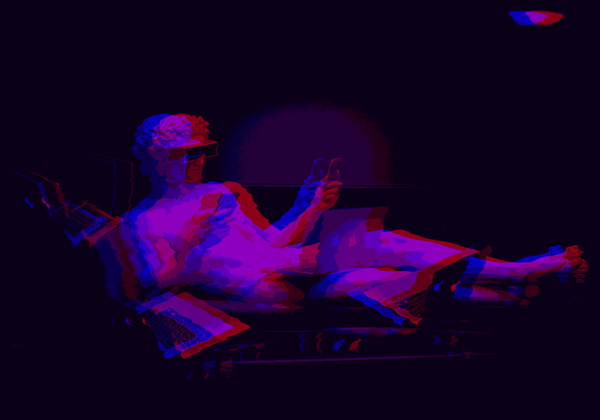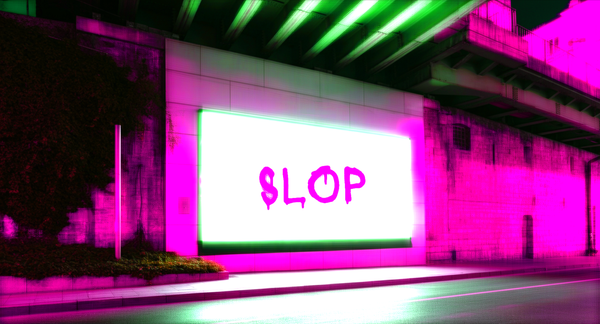The spectre of good design
Today's design leader holds an impossible position, performing care work within extractive systems that optimize for engagement over well-being. This cannot be resolved through better processes or ethical frameworks; it should be a condition within which design's potential emerges.

In 2022, I wrote an article talking about 5 important responsibilities of leading effective design teams. I wrote this article while being between jobs and being a hopeful DesignOps professional. Since then, a lot has happened (inside that lot, a burnout that has changed the course of my career). Since then, design has undergone significant changes. Our tools have changed, too. So it was due time to rethink what the responsibilities are, and how they reshape leaders within the design profession.
Design leadership operating within business-as-usual, in 2025, feels like an administrative bureaucracy created for managing the very creativity that design — as a profession — claims to unleash. We speak of "empowering teams", and then we are implementing systems that quantify every action, punishing designers when they need time to sit and think as being non-productive. The closer design comes to realizing its potential as a space for experimentation and care, the more intensively it must be disciplined into the dry logic of business outcomes. As if this is normal. Have we forgotten what we preach?
What emerged from the massive tech layoffs (after the COVID-19 lockdowns) was not a leaner industry but the complete subsumption of design into business-as-usual (BAU). Companies seem to have finally shed the dangerous idea that technology should serve human needs rather than growth imperatives.
This was not random market volatility. Efforts (like Design Operations, or any non-customer-facing subprofession) created to scale humanistic practices became institutional memory of a time when technology companies at least pretended to care about users. The introduction of artificial intelligence, as the latest addition to an endless fetishization for performance, now threatens to replace not just human labor but human judgment, ethics, and the consideration of consequence.
The last forty years have witnessed the systematic capture of notions of liberatory possibilities that design might have held. What we now call "design thinking" — once supposedly a bold approach to change companies to be more human-centered — represents the successful domestication of practices that once had the possibility to dissolve the boundaries between user and maker.
In the early days of personal computing, design carried the dream of a world where anyone could reshape their technological environment to fit their persona. The Homebrew Computer Club, the early internet communities, or the democratic promise of hypertext, all pointed toward forms of a digital culture that was genuinely participatory. Users weren't consumers but collaborators in an ongoing experiment with new ways of thinking and being together.
Unfortunately, this potential was exorcised. The user became a research subject, their needs interpreted and translated by professional intermediaries working within corporate structures. The user was abstracted even further, tucked into convenient personas that showed up on corporate walls and appeased executives who touted that they are all "customer first".
So today's design leader occupies an impossible position. They may perform some sort of care work, yet this care work is embedded within extractive systems that optimize for engagement over wellbeing, and data capture over human thriving.
This contradiction cannot be resolved through better processes or just another ethical framework. It must be inhabited as the condition within which design's political potential emerges. The most radical gesture available to design leadership may be to acknowledge this impossibility rather than choosing to ignore it.
Given this analysis, the conventional wisdom about design leadership becomes not just inadequate but actively complicit in maintaining the very systems it claims to want to change. The traditional responsibilities of design leadership, being the glue that holds cross-functional teams together, championing change upward to executives, designing the designer journey, fostering safe environments, and doing the design work, all operate within a framework that accepts the fundamental premises of extraction and endless growth.
- They may assume that design can be reformed from within corporate structures and change the very structures that invest or divest in it.
- They may assume that better processes will lead to more humane outcomes, while the broader system of labor remains unchanged.
- They may assume that individual leadership can overcome systemic contradictions that keep individuals constrained from changing anything meaningful.
On the contrary, I am convinced that we need to reconceive leadership not as managing away an impossible position but as inhabiting this impossibility in ways that keep alive the possibility of genuine transformation. This requires abandoning the fantasy of resolving design's contradictions and instead using them as leverage points for practices that exceed their institutional capture.
Five responsibilities for an impossible leader
Amplify collective intelligence
Design leadership's radical potential lies in creating conditions where collective intelligence can emerge. This means designing not just products but the social relations within which products or services are conceived.
Contemporary teams may have forgotten that meaningful work requires the actual democratization of the conditions of work. Today's design teams, despite their collaborative rhetoric, remain fundamentally hierarchical. The designer's expertise is positioned as interpretive, translating user needs into technical specifications rather than creating genuine spaces for co-creation.
Real amplification of collective intelligence would mean dismantling the expert/amateur divide that structures the contemporary design practice. It would mean creating spaces where users become co-designers, where the boundaries between making and using dissolve.
Resist the quantification of care
Design organizations are nowadays pushed to render care legible to business logic. However, this quantification doesn't create anything meaningful or something that you can learn from.
Design leadership's responsibility lies in protecting spaces that resist measurement. This means defending research methods that prioritize depth over scale, advocating for design decisions that cannot be A/B tested, or maintaining practices that acknowledge the irreducible singularity of each user encounter.
The best design work happens in the qualitative dimensions that escape capture by analytics platforms. It exists in the pause to think, when an interface anticipates a need, or in the small relief of finding exactly what you're looking for. These experiences cannot be optimized because they emerge from genuine attention to particularity rather than statistical generalization.
Create conditions for encounter
The smoothness that design promises (the elimination of friction, the optimization of flows, the seamless integration of human and machine) forecloses the possibility of genuine encounter. Moments when users exceed the system's expectations, or use tools in ways never intended.
The potential of design lies not in perfecting the user experience but in leaving space for the unexpected. Consider the early internet's capacity for serendipitous discovery, the way hypertext enabled genuinely non-linear exploration. Contemporary platform design eliminates this unpredictability in favor of algorithmic curation. The user's journey becomes a managed experience rather than a genuine exploration.
Design leadership committed to encounter would resist the totalizing impulse of contemporary UX. It would defend spaces of uncertainty, moments where the system admits it doesn't know what the user wants or needs.
Protect time against urgency
The contemporary workplace is organized around artificial scarcity and manufactured urgency that prevents deep engagement with problems. Design leaders perpetuate this urgency through sprint-based methodologies, rapid prototyping cycles, and continuous delivery pipelines that eliminate time for genuine experimentation.
The psychedelic consciousness that emerged in the 1960s understood time differently. It created spaces where conversations could unfold without predetermined endpoints, where ideas could develop according to their own logic rather than external deadlines. This temporal generosity was a precondition for the kind of collective experimentation that produced genuine innovation.
Design leadership's responsibility involves protecting different kinds of time within organizations driven by quarterly metrics and competitive pressures. This means defending research phases that resist premature closure, design exploration that follows curiosity rather than predetermined outcomes, and user testing that prioritizes understanding over validation.
Maintain conditions of refusal
Every design decision represents a choice about what kind of future we want to create. Contemporary design practice obscures this political dimension through appeals to user-centeredness and evidence-based decision making. But there is no neutral user research, no objective usability metric. Every interface encodes particular values, assumptions about how people should relate to technology and each other.
Design leadership's responsibility may be maintaining the capacity to refuse. To say no to dark patterns even when they increase conversion rates. To reject surveillance features even when they enable personalization. To resist platform integrations that compromise user privacy, even when they improve engagement metrics.
This refusal cannot be based on abstract ethical principles but must emerge from sustained attention to the conditions within which design work happens. It requires understanding how design decisions reinforce or challenge existing power relations, how interfaces reproduce or interrupt patterns of domination.
Design that could be good
The transformation of design will not come from better leadership frameworks or more sophisticated processes. It requires recognizing that design's current form is inseparable from the social relations within which it is embedded. The question is whether design practice can maintain spaces where different relations become possible.
The spectre of a design that could be free haunts every user research session, every design critique, every stakeholder presentation, every prototype that imagines something different and genuine. It appears in moments when users appropriate tools for purposes never intended, or when team members glimpse possibilities that exceed current project constraints.
Design leadership committed to this spectre would abandon the fantasy of managing creativity and instead focus on creating conditions where collective experimentation becomes possible. It would recognize that the most important design work happens in the unmeasurable spaces between intention and outcome, in the encounters that escape capture by existing frameworks.
The revolution in design, like all genuine revolutions, will be as much psychological as social. It will require new forms of consciousness, new ways of relating to technology and each other. The material conditions for this transformation already exist. What remains is to construct the existential and political conditions within which design's liberatory potential can be realized.
The future of design lies in creating spaces where the distinction between user and maker dissolves, where technology becomes a medium for collective intelligence rather than individual consumption. This is design's radical responsibility: to smuggle care into the heart of the machine while maintaining openness to forms of relation that go beyond current imagination.
The spectre of design that could be free continues to haunt our optimized workflows and measured outcomes. Will we have the courage to stop running from it?




